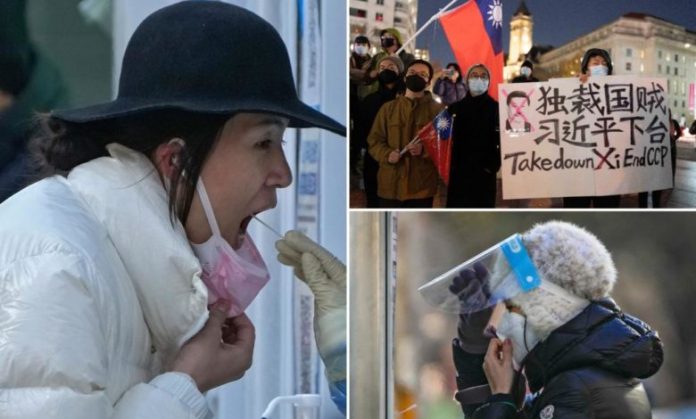In a sharp reversal, China has announced a series of measures rolling back some of the most draconian anti-COVID-19 restrictions.
The Wednesday announcement includes limiting the scale of lockdown to individual apartment floors and buildings, rather than entire districts and neighborhoods.
According to a report,
China rolled back rules on isolating people with COVID-19 and dropped virus test requirements for some public places Wednesday in a dramatic change to a strategy that confined millions of people to their homes and sparked protests and demands for President Xi Jinping to resign.
China has enforced some of the world’s strictest curbs, disrupting global manufacturing and trade and the lives of ordinary Chinese, while many nations switched to trying to live with the virus.
The latest announcement from the National Health Commission is the second easing of rules following a Nov. 11 change that fueled hopes the Communist Party would scrap its “zero COVID” strategy. Experts warn, however, that because millions of elderly people still need to be vaccinated, it will be mid-2023 or later before restrictions can be lifted completely.
China’s low infection rates also mean few people have developed natural immunity, a factor that might set back reopening plans if cases surge and authorities feel compelled to reimpose restrictions.
The easing is in line with promises to reduce the human cost of “zero COVID,” including changes announced before the protests that included shorter quarantines for travelers from abroad. The latest moves have been highly publicized — a possible effort to quell public anger — but it was unclear whether they were a response to the protests.
Under the new rules, people with mild cases will be allowed for the first time to isolate at home instead of going to sometimes overcrowded or unsanitary quarantine centers. That addresses a major irritation that drove the outpouring of anger.
Public facilities except for “special places,” such as schools, hospitals and nursing homes, will no longer require visitors to produce a “health code” on a smartphone app that tracks their virus tests and whether they have been to areas deemed at high risk of infection, the government said.
Local officials must “take strict and detailed measures to protect people’s life, safety and health” but at the same time “minimize the impact of the epidemic on economic and social development,” the statement said.
The latest changes are “small steps” in a gradual process aimed at ending restrictions, said Liang Wannian, a member of an experts group advising the National Health Commission, at a news conference.
“We will look at it, study and judge, and analyze again,” said Liang, one of China’s most prominent anti-epidemic experts.
The government’s goal is “to return to the state before the epidemic, but the realization of the goal must have conditions,” Liang said.
China’s restrictions have helped to keep case numbers low, but public frustration is rising as millions of people are repeatedly confined at home for uncertain periods, schools close abruptly and economic growth falls.
The changes have been rolled out despite a renewed spike in infections started in October. On Wednesday, the government reported 25,231 new cases, including 20,912 without symptoms.
Xi’s government has held up “zero COVID” as proof of the superiority of China’s system compared with the United States and Western countries. China’s official death toll is 5,235 since the start of the pandemic versus a U.S. count of 1.1 million.
There was no indication Beijing was dropping its goal of trying to stamp out transmission of the virus, which has killed at least 6.6 million people worldwide.
China is the last major country still trying to do that while the United States and other governments have eased travel and other curbs.
A deputy premier, Sun Chunlan, said last week that the latest variants were less likely to cause illness. That suggested the government might be preparing to declare COVID-19 a less serious disease, which might lead to a less drastic response, but there has been no confirmation of that.
READ ALSO: Iran achieved all cutting-edge military tech existing in world – IRGC chief
The government announced a campaign last week to vaccinate the elderly that health experts say must be done before China can end restrictions on visitors coming from abroad. They say the ruling party also needs to build up China’s hospital system to cope with a possible rise in cases.
Rules were left in place that warn apartment and office buildings might be sealed if infections are found. Complaints that families are confined for weeks at a time with uncertain access to food and medicine were a key driver of the protests.
The ruling party switched early this year to suspending access to neighborhoods or districts where infections were discovered instead of isolating whole cities.
On Wednesday, the government said the scope of closures will be narrowed still further to single apartment floors or buildings instead of neighborhoods.
It said schools in communities with no outbreaks must return to in-person teaching.
That appeared to be a response to complaints that local leaders, threatened with the loss of their jobs in the event of outbreaks, impose closures that are destructive, might be unnecessary and exceed what the central government allows.
The demonstrations in at least eight major cities and on dozens of university campuses were the most widespread display of public dissent in decades. In Shanghai, some protesters shouted the politically explosive demand for Xi, China’s most influential figure in decades, to resign.
The Post













